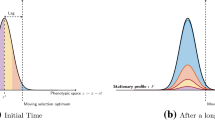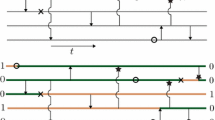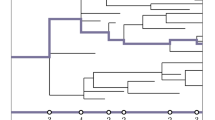Abstract
We reconsider the deterministic haploid mutation–selection equation with two types. This is an ordinary differential equation that describes the type distribution (forward in time) in a population of infinite size. This paper establishes ancestral (random) structures inherent in this deterministic model. In a first step, we obtain a representation of the deterministic equation’s solution (and, in particular, of its equilibria) in terms of an ancestral process called the killed ancestral selection graph. This representation allows one to understand the bifurcations related to the error threshold phenomenon from a genealogical point of view. Next, we characterise the ancestral type distribution by means of the pruned lookdown ancestral selection graph and study its properties at equilibrium. We also provide an alternative characterisation in terms of a piecewise-deterministic Markov process. Throughout, emphasis is on the underlying dualities as well as on explicit results.









Similar content being viewed by others
References
Athreya KB, Ney P (1972) Branching processes. Springer, Berlin
Athreya SR, Swart JM (2005) Branching-coalescing particle systems. Probab Theory Relat Fields 131:376–414
Baake E, Wiehe T (1997) Bifurcations in haploid and diploid sequence space models. J Math Biol 35:321–343
Baake E, Lenz U, Wakolbinger A (2016) The common ancestor type distribution of a \(\varLambda \)-Wright–Fisher process with selection and mutation. Electron Commun Probab 21:1–14
Bürger R (2000) The mathematical theory of selection, recombination, and mutation. Wiley, Chichester
Clifford P, Sudbury A (1985) A sample path proof of the duality for stochastically monotone Markov processes. Ann Probab 13:558–565
Cordero F (2017a) The deterministic limit of the Moran model: a uniform central limit theorem. Markov Process Relat Fields 23:313–324
Cordero F (2017b) Common ancestor type distribution: a Moran model and its deterministic limit. Stoch Process Appl 127:590–621
Crow JF, Kimura M (1956) Some genetic problems in natural populations. In: Neyman J (ed) Proceedings of third Berkeley symposium on mathematical statistics and probability, vol 4, pp 1–22
Crow JF, Kimura M (1970) An introduction to population genetics theory. Harper & Row, New York
Donnelly P, Kurtz TG (1999) Particle representations for measure-valued population models. Ann Probab 27:166–205
Durrett R (2008) Probability models for DNA sequence evolution, 2nd edn. Springer, New York
Eigen M (1971) Self-organization of matter and the evolution of biological macromolecules. Naturwissenschaften 58:465–523
Eigen M, McCaskill J, Schuster P (1989) The molecular quasi-species. Adv Chem Phys 75:149–263
Ethier SN, Kurtz TG (1986) Markov processes: characterization and convergence. Wiley, Chichester
Ewens W (2004) Mathematical population genetics 1: theoretical introduction. Springer, New York
Fearnhead P (2002) The common ancestor at a nonneutral locus. J Appl Probab 39:38–54
Feller W (1951) Diffusion processes in genetics. In: Neyman J (ed) Proceedings of second Berkeley symposium on mathematical statistics and probability 1950. University of California Press, Berkeley, Los Angeles, CA, pp 227–246
Fisher RA (1930) The genetical theory of natural selection. Clarendon Press, Oxford
Georgii H-O, Baake E (2003) Supercritical multitype branching processes: the ancestral types of typical individuals. Adv Appl Probab 35:1090–1110
Jagers P (1989) General branching processes as Markov fields. Stoch Process Appl 32:183–212
Jagers P (1992) Stabilities and instabilities in population dynamics. J Appl Probab 29:770–780
Jansen S, Kurt N (2014) On the notion(s) of duality for Markov processes. Probab Surv 11:59–120
Karlin S, McGregor J (1957) The classification of birth and death processes. Trans Am Math Soc 86:366–400
Krone SM, Neuhauser C (1997) Ancestral processes with selection. Theor Popul Biol 51:210–237
Kurtz TG (1970) Solutions of ordinary differential equations as limits of pure jump Markov Processes. J Appl Probab 7:49–58
Lenz U, Kluth S, Baake E, Wakolbinger A (2015) Looking down in the ancestral selection graph: a probabilistic approach to the common ancestor type distribution. Theor Popul Biol 103:27–37
Liggett TM (2010) Continuous time Markov processes. An introduction. American Mathematical Society, Providence
Malécot G (1948) Les Mathématiques de l’Hérédité. Masson, Paris
Mano S (2009) Duality, ancestral and diffusion processes in models with selection. Theor Popul Biol 75:164–175
Moran PAP (1958) Random processes in genetics. Math Proc Camb Philos Soc 54:60–71
Norris JR (1998) Markov chains, 2nd edn. Cambridge Univ. Press, Cambridge
Shiga T, Uchiyama K (1986) Stationary states and their stability of the stepping stone model involving mutation and selection. Probab Theory Relat Fields 73:87–117
Taylor JE (2007) The common ancestor process for a Wright–Fisher diffusion. Electron J Probab 12:808–847
Wakeley J (2009) Coalescent theory: an introduction. Roberts & Co, Greenwood Village
Wright S (1931) Evolution in Mendelian populations. Genetics 16:97–159
Zanini F, Puller V, Brodin J, Albert J, Neher RA (2017) In vivo mutation rates and the landscape of fitness costs of HIV-\(1\). Virus Evol 3:vex003
Acknowledgements
It is our pleasure to thank Anton Wakolbinger and Ute Lenz for stimulating and fruitful discussions. Furthermore, we are grateful to Anton Wakolbinger, Jay Taylor, and an unknown referee for helpful comments on the manuscript. This project received financial support from Deutsche Forschungsgemeinschaft (Priority Programme SPP 1590 Probabilistic Structures in Evolution, Grant No. BA 2469/5-1, and CRC 1283 Taming Uncertainty, Project C1).
Author information
Authors and Affiliations
Corresponding author
Rights and permissions
About this article
Cite this article
Baake, E., Cordero, F. & Hummel, S. A probabilistic view on the deterministic mutation–selection equation: dynamics, equilibria, and ancestry via individual lines of descent. J. Math. Biol. 77, 795–820 (2018). https://doi.org/10.1007/s00285-018-1228-8
Received:
Revised:
Published:
Issue Date:
DOI: https://doi.org/10.1007/s00285-018-1228-8
Keywords
- Mutation–selection equation
- Pruned lookdown ancestral selection graph
- Killed ancestral selection graph
- Error threshold




